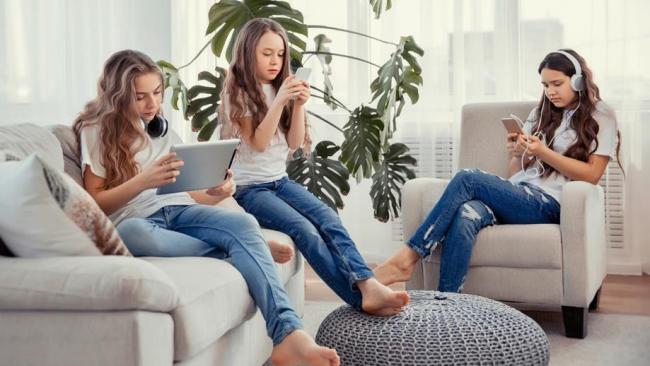More than 1 billion young people risking their hearing
More than 1 billion young people around the world are risking deafness by listening to loud noise through headphones, prompting the UN to issue international safe-volume standards

READING LEVEL: ORANGE
More than one billion young people risk damaging their hearing through dangerous use of smartphones and other audio devices.
In a bid to prevent a global health epidemic*, the United Nations’ (UN) has issued international safe-listening standards.
The standards apply to makers of audio devices and to users to inform them when their listening volume and duration* is unsafe.
They have been likened to the safety standards we have for driving.
“Think of it like driving on a highway, but without a speedometer* in your car or a speed limit,” Dr Shelly Chadha of the UN’s World Health Organisation said.
“What we’ve proposed is that your smartphones come fitted with a speedometer, with a measurement system which tells you how much sound you’re getting and tells you if you are going over the limit”.
Young people are particularly prone* to risky listening habits.

Around half of all people between the ages of 12 and 35, or 1.1 billion people, are at risk due to “prolonged* and excessive* exposure to loud sounds, including music they listen to through personal audio devices,” the World Health Organisation (WHO) said.
WHO chief Tedros Adhanom Ghebreyesus pointed out that the world already has “the technological know-how to prevent hearing loss”.
“It should not be the case that so many young people continue to damage their hearing while listening to music,” he said in a statement.
Young people, he said, “must understand that once they lose their hearing, it won’t come back.”
Currently, about five per cent of the global population, or some 466 million people, including 34 million children, suffer from disabling hearing loss.

WHO intends that the new standards, developed with the UN’s International Telecommunications Union, would go a long way to “safeguard these young consumers as they go about doing something they enjoy.”
WHO considers a volume above 85 decibels* for eight hours or 100 decibels for 15 minutes as unsafe.
The safety standards call for “sound allowance” software to be included in all audio devices, to track the volume and how long the listener is exposed to sound, and to assess the risk to their hearing.
This system could alert a user if they have dangerous listening habits.
WHO is also calling for parental as well as automatic volume controls on audio devices to prevent dangerous use.
While some smartphones and other audio devices already offer some of these features, the UN is proposing a uniform standard used to help protect against disabling hearing loss.
VIDEO: What can you hear?
HOW LOUD IS THAT?
Sound is measured in decibels, often written as dB.
- Zero decibels, or 0dB, is the softest sound that a person with normal hearing can hear.
- Breathing, which we can barely hear, is about 10dB.
- A whisper, or rustling leaves, is about 20dB.
- Conversation indoors or an airconditioner about 30m away, 60dB.
- Vacuum cleaner, about 70dB, which is about the level at which noise becomes annoying to some people.
- Food blender, about 88dB.
- Farm tractor, about 100dB.
- Jet taking off 25m away, about 150dB.
Source: Parliament of Australia
GLOSSARY
- epidemic: widespread occurrence of a disease or problem
- duration: how long for
- speedometer: speed measurement equipment in a car
- prone: at risk
- prolonged: for a long time
- excessive: too much
- decibels: unit of measurement for sound
EXTRA READING
What do you hear, Yanny or Laurel?
iPhone helps the deaf hear music
Vaccinations eliminate rubella from Australia
QUICK QUIZ
- What does WHO stand for?
- What has a speedometer got to do with this story?
- How many children around the world suffer from disabling hearing loss?
- What does dB stand for?
- How many decibels is the noise of a tractor?
LISTEN TO THIS STORY
CLASSROOM ACTIVITIES
List the benefits
Make a list of the benefits of including a measurement system of tracking and informing users when their listening habits are unsafe.
Think about the effect the continued unsafe use could have on themselves, their families and the community.
Can you think of any limitations of this technology? Make a list of the limitations it may have.
For example, can it detect how far from the device you are?
Time: allow 15 minutes to complete this activity
Curriculum Links: English, Critical and Creative Thinking, Technologies – Design and Technologies
2. Extension
Do you think that including these safeguards in devices will prevent hearing loss?
Write an exposition (persuasive piece) presenting your opinion of whether including a measurement system in audio devices is necessary and if it will have the desired impact.
Write your opinion in a few paragraphs giving reasons why you believe it necessary or unnecessary.
Time: allow 20 minutes to complete this activity
Curriculum Links: English, Critical and Creative Thinking, Technologies – Design and Technologies
VCOP ACTIVITY
After reading the article, with a partner, highlight as many wow words or ambitious pieces of vocabulary that you can find in yellow. Discuss the meanings of these words and see if you can use them orally in another sentence.
HAVE YOUR SAY: Do you think it is a good idea to protect your hearing? Do you think safe-listening standards are a good idea?
No one-word answers. Use full sentences to explain your thinking.

